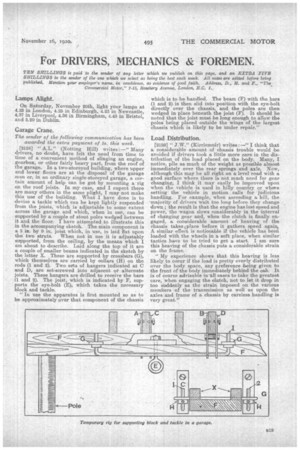For DRIVERS, MECHANICS & FOREMEN.
Page 29

If you've noticed an error in this article please click here to report it so we can fix it.
TEN SHILLINGS is paid to the sender of any letter which we publish, on this page, and an EXTRA FIVE SHILLINGS to the sender of the one which we select as being the best each week. All notes are edited before being published, Mention your employer's name, in confidence, asevidence of good faith. Address, D., M. and F., "The. Commercial Motor," 7-25, Rosebery Avenue, London, EX. 1..
Lamps Alight.
On Saturday, November 20th, light your lamps at 4.33 in London, 4.25 in Edinburgh, 4.23 in Newcastle, 4.37 in Liverpool, 4.36 in Birmingham, 4.43 in Bristol, and 6.20 in Dublin.
Garage Crane.
The sender of the following communication has been awarded the extra payment of 5s. this week. '
[2158j " A.L." (Notting Hill) writes :—" Many drivers, no doubt, have felt the need from time to time of a convenient method of slinging an engine, gearbox, or other fairly heavy part, from the roof of the garage. In a two-storeyed building, where upper and lower floors are at the disposal of the garage man or, in an ordinary single-storeyed garage, a certain amount of help can be got by mounting a-rig on the roof joists. In my case, and I expect there are many others in the same plight, I may not make this use of the building. What -I have done is to devise a tackle which can be kept lightly suspended from the joists, which is adjustable to some extent across the garage and which, when in use, can be supported by a couple of stout poles wedged between it and the floor. I have attempted to illustrate this in the accompanying sketch. The main component is a 3 in. by 9 in. joist which, in use, is laid flat upon the two struts. When not in use it is adjustably supported, from the ceiling, by the means which I am about to describe. Laid along the top of it are a couple of smaller beams indicated in the sketch by the letter X. These are supported by crossbars (G), which themselves are carried by collars (H) on the rods (1 and 2). Two sets of hangers indicated at C and D, are set-screwed into adjacent or alternate joists. These hangers are drilled to receive the bars (1 and 2). The joist, which is indicated by F, supports the eye-bolt (E), which takes the necessary block and tackle.
"In use the apparatus is first mounted so as to be approximately over that component of the chassis which is to be handled. The beam (F) with the bars (1 and 2) is then slid into position with the eye-bolt directly over the chassis, and the poles are then wedged in place beneath the joist (F). It should be noted that the joist must be long enough to allow the poles being placed outside the wings of the largest chassis which is likely to be under repair."
Load Distribution.
[21591 " J.W." (Kirriemuir) writes :—" I think that a considerable amount of chassis trouble would be avoided if drivers took a little more care in the distribution of the load placed on the body. Many, I notice, pile as much of the weight as possible almost immediately over the rear springs and axle. Now, although this may be an right on a level road with a good surface where there is not much need for gear changing, I think .it may easily be improved upon when the vehicle is used in hilly country or where setting the vehicle in motion calls for judicious handling. For example, when ascending a hill, the -majority of drivers wait too long before they change down ; the result is that the engine has lost speed and power, the wagon slows considerably in the interval of changing gear and, when the clutch is finally engaged, a considerable amount of heaving of the chassis takes.iplace before it gathers speed again, A similar effect is noticeable if the vehicle has been loaded with the wheels in a soft place, when similar tactics have to be tried to get a start. I am sure this heaving of the chassis puts a considerable strain on the frame.
"My experience shows that this heaving is less likely to occur if the load is pretty evenly distributed over the body space, any preference being given to the front of the body immediately behind the cab. It is of course advisable in-all cases to take the greatest care, when engaging the clutch, not to let it drop in too suddenly as the strain imposed on the various members of the transmission as well as upon the axles and frame of a chassis by careless handling is very great."






























